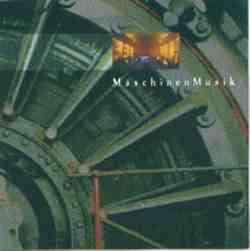
Program:
Total Time: 43:18
Released: 2000
Review Date: July 2001
Order from:
Ralf Kaupenjohann
Email: AUGEMUS@t-online.de
Review by
Henry Doktorski:
Such an interesting CD, with an interesting title "Maschinen Musik;" its sounds are generated for the most part by percussion instruments and objects, although the accordion and the speaking voice figure prominently in the first composition.
The concept of music by and for machines first appeared in the movement known as Futurism, launched in 1909 by a group of Italian artists and writers, especially Filippo T. Marinetti, Francesco Pratella and Luigi Russolo. Futurism was the self-proclaimed art of the machine age and, in keeping with this aesthetic, Russolo postulated noise as a basic material in composition. He built machines to produce such nonmusical noises as "rumblers," "thunderers," "crushers," "whistlers," "gurglers," and "screamers," composed works like The Meeting of Automobile and Aeroplane and conducted a concert in Milan in 1913 that produced a riot.
In 1926 the American composer George Antheil (1900-1959) -- who also wrote a piece for accordion and orchestra -- continued in the Futuristic tradition by composing his signature piece: Ballet mecanique, which employed a pianola, sixteen pianos, eight xylophones, electric doorbells, anvils, buzz saws, automobile horns, and an airplane propellor.
In 1933, the Frenchman, Edgar Varese (1885-1965) (living in the United States) continued the tradition by composing Ionisation for thirteen percussionists incorporating an unprecedented variety of hitherto less common instruments, most of them unpitched (e.g., sleigh-bells, sirens, anvils, giuros, temple blocks, whip).
Maschinen Musik has a long tradition. On this CD I enjoyed listening to "Um-Form" and "Tentekko." Both employ a variety of percussion instruments. The accordion, however, is heard only in the first piece, and that is the one I will concentrate on.
The accordion, sensitively played by Ralf Kaupenjohann, the German performer, scholar and publisher, is featured as a melodic foil (or contrast) to the percussion instruments. "Um-Form" is made up of eight parts which appear in four pairs. The first track of each pair features percussion, and the second track of each pair features the accordion, in conjunction with a speaking voice part. In opposition to the unpitched percussive instruments, the accordion part (with the exception of the first pair) is melodic and for the most part harmonic, although perhaps not in a triadic sense. It is really quite beautiful and accompanies the voice perfectly.
It is a pity I do not read German, as the CD booklet notes are only written in that language. I'm sure I would appreciate the music more by understanding the text which the music supports.
The works on this CD were performed at a live concert to an appreciative audience. I think lovers of the classical accordion will also appreciate listening to this CD, especially if they also enjoy listening to musique concrete.
| About The Free-Reed Review |
| Invitation to Contributors / Submission Guidelines |
| Back to The Free-Reed ReviewContents Page |
| Back to The Classical Free-Reed, Inc. Homepage |